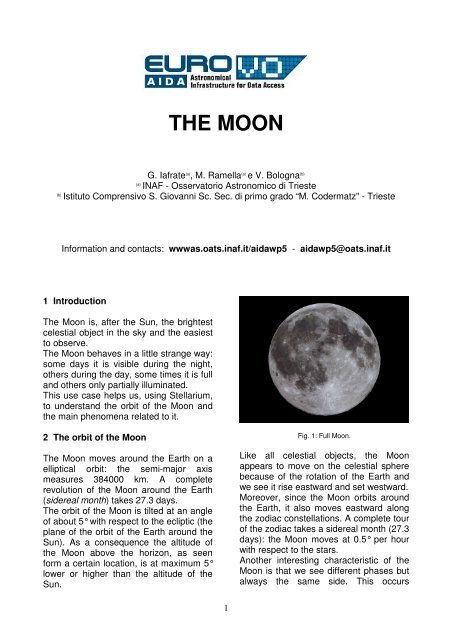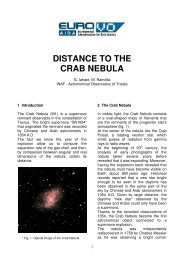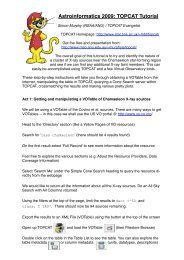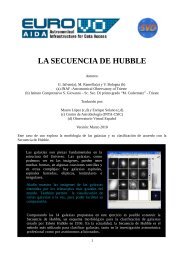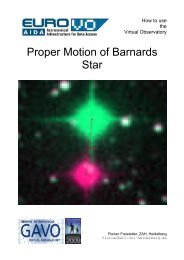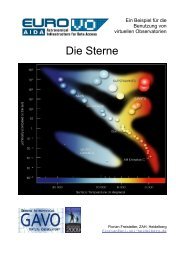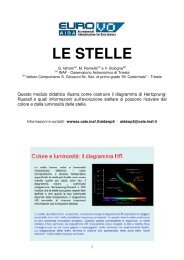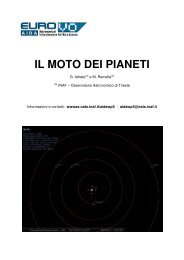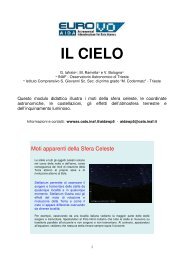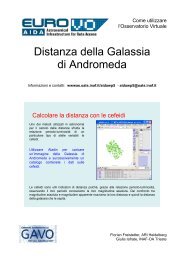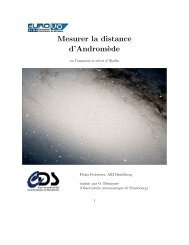Orbit of the Moon, sidereal and synodic period, phases ... - INAF
Orbit of the Moon, sidereal and synodic period, phases ... - INAF
Orbit of the Moon, sidereal and synodic period, phases ... - INAF
- No tags were found...
You also want an ePaper? Increase the reach of your titles
YUMPU automatically turns print PDFs into web optimized ePapers that Google loves.
THE MOONG. Iafrate (a) , M. Ramella (a) e V. Bologna (b)(a)<strong>INAF</strong> - Osservatorio Astronomico di Trieste(b)Istituto Comprensivo S. Giovanni Sc. Sec. di primo grado “M. Codermatz" - TriesteInformation <strong>and</strong> contacts: wwwas.oats.inaf.it/aidawp5 - aidawp5@oats.inaf.it1 IntroductionThe <strong>Moon</strong> is, after <strong>the</strong> Sun, <strong>the</strong> brightestcelestial object in <strong>the</strong> sky <strong>and</strong> <strong>the</strong> easiestto observe.The <strong>Moon</strong> behaves in a little strange way:some days it is visible during <strong>the</strong> night,o<strong>the</strong>rs during <strong>the</strong> day, some times it is full<strong>and</strong> o<strong>the</strong>rs only partially illuminated.This use case helps us, using Stellarium,to underst<strong>and</strong> <strong>the</strong> orbit <strong>of</strong> <strong>the</strong> <strong>Moon</strong> <strong>and</strong><strong>the</strong> main phenomena related to it.2 The orbit <strong>of</strong> <strong>the</strong> <strong>Moon</strong>The <strong>Moon</strong> moves around <strong>the</strong> Earth on aelliptical orbit: <strong>the</strong> semi-major axismeasures 384000 km. A completerevolution <strong>of</strong> <strong>the</strong> <strong>Moon</strong> around <strong>the</strong> Earth(<strong>sidereal</strong> month) takes 27.3 days.The orbit <strong>of</strong> <strong>the</strong> <strong>Moon</strong> is tilted at an angle<strong>of</strong> about 5° with respect to <strong>the</strong> ecliptic (<strong>the</strong>plane <strong>of</strong> <strong>the</strong> orbit <strong>of</strong> <strong>the</strong> Earth around <strong>the</strong>Sun). As a consequence <strong>the</strong> altitude <strong>of</strong><strong>the</strong> <strong>Moon</strong> above <strong>the</strong> horizon, as seenform a certain location, is at maximum 5°lower or higher than <strong>the</strong> altitude <strong>of</strong> <strong>the</strong>Sun.Fig. 1: Full <strong>Moon</strong>.Like all celestial objects, <strong>the</strong> <strong>Moon</strong>appears to move on <strong>the</strong> celestial spherebecause <strong>of</strong> <strong>the</strong> rotation <strong>of</strong> <strong>the</strong> Earth <strong>and</strong>we see it rise eastward <strong>and</strong> set westward.Moreover, since <strong>the</strong> <strong>Moon</strong> orbits around<strong>the</strong> Earth, it also moves eastward along<strong>the</strong> zodiac constellations. A complete tour<strong>of</strong> <strong>the</strong> zodiac takes a <strong>sidereal</strong> month (27.3days): <strong>the</strong> <strong>Moon</strong> moves at 0.5° per hourwith respect to <strong>the</strong> stars.Ano<strong>the</strong>r interesting characteristic <strong>of</strong> <strong>the</strong><strong>Moon</strong> is that we see different <strong>phases</strong> butalways <strong>the</strong> same side. This occurs1
ecause <strong>the</strong> time it takes <strong>the</strong> <strong>Moon</strong> toperform a rotation around its axis is <strong>the</strong>same it takes to complete an orbit around<strong>the</strong> Earth. This type <strong>of</strong> motion is calledsynchronous rotation (rotation <strong>and</strong>revolution <strong>period</strong>s are equal).3 The <strong>phases</strong> <strong>of</strong> <strong>the</strong> <strong>Moon</strong>The illuminated surface <strong>of</strong> <strong>the</strong> <strong>Moon</strong> <strong>and</strong><strong>the</strong> time <strong>of</strong> rise <strong>and</strong> set change every day.Lunar <strong>phases</strong> depend on <strong>the</strong> mutualpositions <strong>of</strong> Sun, <strong>Moon</strong> <strong>and</strong> Earth.Half <strong>of</strong> <strong>the</strong> surface <strong>of</strong> <strong>the</strong> <strong>Moon</strong> is alwaysilluminated by <strong>the</strong> Sun. Phases are due to<strong>the</strong> fact that we see part <strong>of</strong> <strong>the</strong> illuminatedsurface <strong>and</strong> part <strong>of</strong> <strong>the</strong> dark side, in ratiosthat change day by day.A phase is defined by shape, size <strong>and</strong>orientation <strong>of</strong> <strong>the</strong> illuminated surface <strong>of</strong><strong>the</strong> <strong>Moon</strong> that is visible to us.From Earth we see <strong>the</strong> <strong>Moon</strong> with <strong>the</strong>same phase after a <strong>synodic</strong> month (29.5days). The reason because <strong>the</strong> <strong>synodic</strong>month is longer than <strong>the</strong> <strong>sidereal</strong> monthis <strong>the</strong> following: during a <strong>sidereal</strong> month<strong>the</strong> Earth covers nearly one twelfth <strong>of</strong> itsorbit around <strong>the</strong> Sun. In order to have <strong>the</strong>same Sun-<strong>Moon</strong>-Earth configuration, <strong>and</strong>thus <strong>the</strong> same phase <strong>of</strong> <strong>the</strong> <strong>Moon</strong>, <strong>the</strong><strong>Moon</strong> has to cover one more twelfth <strong>of</strong> itsorbit around <strong>the</strong> Earth. This additionalmotion takes slightly longer than 2 days<strong>and</strong> hence lunar <strong>phases</strong> repeat every<strong>sidereal</strong> month + 2 days = 29.5 days.The main lunar <strong>phases</strong> are: new moon,first quarter, full moon <strong>and</strong> last quarter.New moon: <strong>the</strong> <strong>Moon</strong> is located between<strong>the</strong> Sun <strong>and</strong> <strong>the</strong> Earth <strong>and</strong> <strong>the</strong> illuminatedside is not visible from Earth. We can notsee <strong>the</strong> <strong>Moon</strong> in <strong>the</strong> sky.First quarter: <strong>the</strong> <strong>Moon</strong> is at 90° withrespect to <strong>the</strong> Sun-Earth direction. From<strong>the</strong> Earth we see exactly half illuminatedsurface <strong>and</strong> half dark surface.Full moon: <strong>Moon</strong>, Earth <strong>and</strong> Sun arealigned, as in <strong>the</strong> case <strong>of</strong> new moon, butnow <strong>the</strong> <strong>Moon</strong> is located at <strong>the</strong> oppositeside <strong>of</strong> <strong>the</strong> Earth with respect to <strong>the</strong> Sun.We see <strong>the</strong> entire <strong>Moon</strong> disk illuminated.Third (last) quarter: as <strong>the</strong> first quarterphase, <strong>the</strong> <strong>Moon</strong> is at 90° with respect to2<strong>the</strong> Sun-Earth direction, but now on <strong>the</strong>opposite side. From <strong>the</strong> Earth we seeexactly half illuminated surface <strong>and</strong> halfdark surface.The <strong>Moon</strong> not only displays a change <strong>of</strong><strong>phases</strong>, but also rises, reaches <strong>the</strong>maximum height above <strong>the</strong> horizon(culminates) <strong>and</strong> sets at different times.For example, since <strong>the</strong> <strong>Moon</strong> is full whenit is opposite to <strong>the</strong> Sun, in this phase itrises at sunset, culminates at midnight<strong>and</strong> sets at dawn. At <strong>the</strong> first quarter <strong>the</strong><strong>Moon</strong> is 90° eastward <strong>of</strong> <strong>the</strong> Sun: it risesat noon, culminates at sunset <strong>and</strong> sets atmidnight.Fig. 2: Scheme <strong>of</strong> <strong>the</strong> lunar <strong>phases</strong>: <strong>the</strong> Earth is at <strong>the</strong>centre <strong>and</strong> <strong>the</strong> Sun is on <strong>the</strong> left, outside <strong>the</strong> picture.(http://astroimperia.altervista.org).4 Solar <strong>and</strong> lunar eclipsesSometimes when <strong>Moon</strong>, Earth <strong>and</strong> Sunare exactly aligned <strong>the</strong>y give rise to aspectacular phenomenon: <strong>the</strong> eclipse.Eclipses can be classified into solar <strong>and</strong>lunar eclipses.A solar eclipse (fig. 3) occurs when <strong>the</strong><strong>Moon</strong> is located between <strong>the</strong> Earth <strong>and</strong><strong>the</strong> Sun <strong>and</strong> casts its shadow on <strong>the</strong>Earth. People who live in regions coveredby <strong>the</strong> shadow <strong>of</strong> <strong>the</strong> <strong>Moon</strong> will see <strong>the</strong>Sun being obscured.We call totality <strong>of</strong> an eclipse <strong>the</strong> momentwhen <strong>the</strong> disk <strong>of</strong> <strong>the</strong> Sun is completelyobscured by <strong>the</strong> <strong>Moon</strong>.
Fig. 3: Scheme <strong>of</strong> a solar eclipse (www.pd.astro.it).During totality we can observe <strong>the</strong> solarcorona (fig. 4). The solar corona is <strong>the</strong>outermost part <strong>of</strong> <strong>the</strong> solar atmosphere,characterized by a very low density. It ismuch less luminous than <strong>the</strong> disk <strong>of</strong> <strong>the</strong>Sun at optical wavelengths <strong>and</strong> <strong>the</strong>reforeusually invisible. The total brightness <strong>of</strong><strong>the</strong> corona is about one millionth <strong>of</strong> <strong>the</strong>total brightness <strong>of</strong> <strong>the</strong> Sun.When a total eclipse occurs while <strong>the</strong><strong>Moon</strong> is at its longest distance from <strong>the</strong><strong>the</strong> Earth (apogee), <strong>the</strong> disk <strong>of</strong> <strong>the</strong> <strong>Moon</strong>can be slightly smaller than <strong>the</strong> disk <strong>of</strong> <strong>the</strong>Sun. In this case a thin annulus <strong>of</strong> <strong>the</strong>Sun remains visible <strong>and</strong> <strong>the</strong> eclipse iscalled annular.During <strong>the</strong> totality <strong>of</strong> a lunar eclipse, <strong>the</strong><strong>Moon</strong> does not disappear completely , butit glows with a faint reddish (fig. 6).The red colour is caused by light from <strong>the</strong>Sun that passes through <strong>the</strong> Earth’satmosphere where green-blue rays areabsorbed.The <strong>Moon</strong> passes between <strong>the</strong> Sun <strong>and</strong><strong>the</strong> Earth every 29.5 days at full <strong>Moon</strong>.So why are eclipses rarer phenomena? Inorder to have an eclipse a very accuratealignment is required. The orbit <strong>of</strong> <strong>the</strong><strong>Moon</strong> is tilted at an angle <strong>of</strong> 5° withrespect to <strong>the</strong> ecliptic. We have an exactalignment only when <strong>the</strong> <strong>Moon</strong> is in one<strong>of</strong> <strong>the</strong> two points where its orbit intersect<strong>the</strong> ecliptic (nodes).Fig. 6: Sequence <strong>of</strong> <strong>the</strong> lunar eclipse <strong>of</strong> March 3 rd ,2007. Note <strong>the</strong> red color during <strong>the</strong> totality.Fig. 4: Total solar eclipse <strong>of</strong> March 29 th , 2006.A lunar eclipse (fig. 5) occurs when <strong>the</strong>Earth is located between <strong>the</strong> Sun <strong>and</strong> <strong>the</strong><strong>Moon</strong> with <strong>the</strong> Earth casting its shadowon <strong>the</strong> <strong>Moon</strong>.Fig. 7: Scheme <strong>of</strong> <strong>the</strong> lunar orbit <strong>and</strong> <strong>the</strong> ecliptic. Note<strong>the</strong> 5° inclination between <strong>the</strong> two planes <strong>and</strong> <strong>the</strong>position <strong>of</strong> <strong>the</strong> nodes (http://www.astronomia.com).Fig. 5: Scheme <strong>of</strong> a lunar eclipse (www.pd.astro.it).It is interesting to note that we can seetotal solar eclipses from <strong>the</strong> Earth bysheer coincidence: <strong>the</strong> Sun <strong>and</strong> <strong>the</strong> <strong>Moon</strong>as seen from <strong>the</strong> Earth appear to have3
<strong>the</strong> same angular diameter even if <strong>the</strong>yhave different sizes.5 StellariumStellarium is a free s<strong>of</strong>tware thattransforms a home computer in aplanetarium. It calculates <strong>the</strong> positions <strong>of</strong>Sun <strong>and</strong> <strong>Moon</strong>, planets <strong>and</strong> stars, <strong>and</strong>draws <strong>the</strong> sky how it would be seen froman observer anywhere on <strong>the</strong> Earth <strong>and</strong>at any epoch. Stellarium can also draw<strong>the</strong> constellations <strong>and</strong> simulateastronomical phenomena such as meteorshowers <strong>and</strong> solar or lunar eclipses.Stellarium may be used as an educationaltool for kids <strong>of</strong> all ages, as anobservational aid for amateurastronomers wishing to plan an observingnight, or simply to explore <strong>the</strong> sky (it isfun!). Stellarium shows a realistic sky,very close to what you see with nakedeye, binoculars or telescope. Stellariumgives astronomical data (coordinates,magnitude, distance, etc.) <strong>of</strong> most <strong>of</strong> <strong>the</strong>celestial objects visualized on <strong>the</strong> screen.You can freely download Stellarium fromour site http://wwwas.oats.inaf.it/aidawp5or from http://www.stellarium.org.6 Observing <strong>the</strong> <strong>Moon</strong> in StellariumObserving <strong>the</strong> <strong>Moon</strong> <strong>and</strong> <strong>the</strong> relatedphenomena in Stellarium is very easy. In<strong>the</strong> left menu we can set location(location window - ) <strong>and</strong> time(date/time window - ), <strong>and</strong> <strong>the</strong>n see if<strong>the</strong> <strong>Moon</strong> is visible in <strong>the</strong> sky. Use <strong>the</strong>mouse wheel in order to increase ordecrease <strong>the</strong> field <strong>of</strong> view <strong>and</strong> pan <strong>the</strong>field <strong>of</strong> view in order to watch a differentpart <strong>of</strong> <strong>the</strong> sky.If <strong>the</strong> <strong>Moon</strong> is visible in <strong>the</strong> sky we canselect it: in <strong>the</strong> upper left corner itsastronomical data will appear.Zoom on <strong>the</strong> <strong>Moon</strong> in order to observe<strong>the</strong> lunar <strong>phases</strong>.If <strong>the</strong> <strong>Moon</strong> is not in <strong>the</strong> sky, it could benot yet risen or already set.Stellarium lets us move forward <strong>and</strong>backward in time, using <strong>the</strong> arrows( ) at <strong>the</strong> right <strong>of</strong> <strong>the</strong> bottommenu. By clicking (more <strong>the</strong>n one time)on <strong>the</strong> button with <strong>the</strong> left or right doublearrow, <strong>the</strong> time is accelerated so we canhave a quick view <strong>of</strong> phenomena lastingmany hours. The button “play - ” bringsback <strong>the</strong> flow <strong>of</strong> time to its st<strong>and</strong>ard rate.After <strong>the</strong> selection <strong>of</strong> <strong>the</strong> <strong>Moon</strong> we canfollow it in order to have <strong>the</strong> <strong>Moon</strong> alwaysin <strong>the</strong> centre <strong>of</strong> <strong>the</strong> screen: push <strong>the</strong>space bar on <strong>the</strong> keyboard or <strong>the</strong> button“centre <strong>the</strong> selected object” - in <strong>the</strong>bottom menu.The same thing can be done for anyastronomical object, including <strong>the</strong> Sun.In order to see (<strong>and</strong> follow) <strong>the</strong> <strong>Moon</strong> alsowhen it is below <strong>the</strong> horizon or during <strong>the</strong>day, we can turn <strong>of</strong>f <strong>the</strong> effects <strong>of</strong>atmosphere (button “atmosphere” - )<strong>and</strong> <strong>the</strong> visualization <strong>of</strong> <strong>the</strong> ground(“ground” - ). Eventually, for a bettervisualization, turn <strong>of</strong>f <strong>the</strong> cardinal points(button “cardinal points” - ). In somecases it could be useful to visualize <strong>the</strong>ecliptic (push comma on <strong>the</strong> keyboard),constellations (button “constellation lines”- ) or o<strong>the</strong>r reference lines on <strong>the</strong>celestial sphere. Such options, <strong>and</strong> manyo<strong>the</strong>rs, can be turned on from <strong>the</strong> leftmenu “sky <strong>and</strong> view options - ”.Stellarium has a plugin that allows tocompute angular distances. Activate itfrom configuration window -> plugins ->angle measure. Select “load at start-up”:at <strong>the</strong> next start up <strong>of</strong> Stellarium <strong>the</strong>button ( ) will appear in <strong>the</strong> bottommenu.Try to measure <strong>the</strong> diameter <strong>of</strong> <strong>Moon</strong> <strong>and</strong>Sun <strong>and</strong> <strong>the</strong> shift <strong>of</strong> <strong>the</strong> <strong>Moon</strong> in one hourwith respect to <strong>the</strong> stars.4
EXERCISESExercise 1Observe <strong>the</strong> <strong>Moon</strong> motion in Stellarium <strong>and</strong> compute <strong>the</strong> duration <strong>of</strong> <strong>the</strong> <strong>sidereal</strong> <strong>and</strong><strong>synodic</strong> lunar months.Hint: turn <strong>of</strong>f atmosphere, cardinal points <strong>and</strong> ground, put <strong>the</strong> <strong>Moon</strong> fixed at <strong>the</strong> centre <strong>of</strong><strong>the</strong> screen <strong>and</strong> turn on ecliptic <strong>and</strong> constellation lines.Switch from equatorial mount to azimuthal mount in order to have <strong>the</strong> ecliptic fixed at <strong>the</strong>centre <strong>of</strong> <strong>the</strong> screen. In order to compute <strong>the</strong> <strong>sidereal</strong> month, move <strong>the</strong> moon (goingforward <strong>and</strong> backward in time) in <strong>the</strong> nearing <strong>of</strong> a easily recognizable constellation <strong>and</strong>observe after how many days <strong>the</strong> <strong>Moon</strong> returns in <strong>the</strong> same position. In order to compute<strong>the</strong> <strong>synodic</strong> month, observe <strong>the</strong> time interval that goes between two equal <strong>phases</strong> <strong>of</strong> <strong>the</strong><strong>Moon</strong>, e.g. between a new moon <strong>and</strong> <strong>the</strong> next one.Exercise 2Paint <strong>the</strong> following circles in order to show how <strong>the</strong> <strong>Moon</strong> appears during different <strong>phases</strong>.new moon first quarter full moon last quarterExercise 3How do people who live in <strong>the</strong> sou<strong>the</strong>rn hemisphere see <strong>the</strong> <strong>Moon</strong>?Observe, from Europe, <strong>the</strong> <strong>Moon</strong> at first quarter <strong>and</strong> draw both <strong>the</strong> phase <strong>and</strong> <strong>the</strong> position<strong>of</strong> some craters. Then move to <strong>the</strong> sou<strong>the</strong>rn hemisphere, e.g. in South Africa, <strong>and</strong> draw<strong>the</strong> <strong>Moon</strong> as you see it from <strong>the</strong>re. What do you notice?EuropeSouth Africa5
Exercise 4Fill <strong>the</strong> following table observing <strong>the</strong> <strong>Moon</strong> in Stellarium in <strong>the</strong> given day <strong>and</strong> location,Pay attention: one <strong>of</strong> <strong>the</strong> eclipses is particular, can you tell which one <strong>and</strong> why?Table columns:Type: solar or lunar eclipse; start, max, end: time <strong>of</strong> start, maximum <strong>and</strong> end <strong>of</strong> <strong>the</strong>eclipse; tot. durat.: how long does <strong>the</strong> totality last; lunar phase: full moon, new moon, firstquarter, etc; visib. Italy: is <strong>the</strong> total eclipse visible from Italy?Date ObserverlatitudeObserverlongitude11/08/1999 45°04’48” N 24°17’18” E21/02/2008 10°00’00” N 50°00’00” W01/08/2008 65°38’48” N 72°16’24” E15/01/2010 01°16’00” S 36°49’00” E15/06/2011 18°55’00” S 47°31’00” E03/11/2013 03°30’06” N 11°41’30” W28/09/2015 00°00’00” N 40°00’00” WType TimestartTimemaxTimeendTotdurat.LunarphaseVisib.Italy6
SOLUTIONSExercise 1Observe <strong>the</strong> <strong>Moon</strong> motion in Stellarium <strong>and</strong> compute <strong>the</strong> duration <strong>of</strong> <strong>the</strong> <strong>sidereal</strong> <strong>and</strong><strong>synodic</strong> lunar months. Sidereal month: 27.3 days, <strong>synodic</strong> month 29.5 days.Hint: turn <strong>of</strong>f atmosphere, cardinal points <strong>and</strong> ground, put <strong>the</strong> <strong>Moon</strong> fixed at <strong>the</strong> centre <strong>of</strong><strong>the</strong> screen <strong>and</strong> turn on ecliptic <strong>and</strong> constellation lines.Switch from equatorial mount to azimuthal mount ( ) in order to have <strong>the</strong> ecliptic fixed at<strong>the</strong> centre <strong>of</strong> <strong>the</strong> screen. In order to compute <strong>the</strong> <strong>sidereal</strong> month, move <strong>the</strong> moon (goingforward <strong>and</strong> backward in time) in <strong>the</strong> nearing <strong>of</strong> a easily recognizable constellation <strong>and</strong>observe after how many days <strong>the</strong> <strong>Moon</strong> returns in <strong>the</strong> same position. In order to compute<strong>the</strong> <strong>synodic</strong> month, observe <strong>the</strong> time interval that goes between two equal <strong>phases</strong> <strong>of</strong> <strong>the</strong><strong>Moon</strong>, e.g. between a new moon <strong>and</strong> <strong>the</strong> next one.Exercise 2Paint <strong>the</strong> following circles in order to show how <strong>the</strong> <strong>Moon</strong> appears during different <strong>phases</strong>.new moon first quarter full moon last quarterExercise 3How do people who live in <strong>the</strong> sou<strong>the</strong>rn hemisphere see <strong>the</strong> <strong>Moon</strong>?Observe, from Europe, <strong>the</strong> <strong>Moon</strong> at first quarter <strong>and</strong> draw both <strong>the</strong> phase <strong>and</strong> <strong>the</strong> position<strong>of</strong> some craters. Then move to <strong>the</strong> sou<strong>the</strong>rn hemisphere, e.g. in South Africa, <strong>and</strong> draw<strong>the</strong> <strong>Moon</strong> as you see it from <strong>the</strong>re. What do you notice?EuropeSouth Africa7
Exercise 4Fill <strong>the</strong> following table observing <strong>the</strong> <strong>Moon</strong> in Stellarium in <strong>the</strong> given day <strong>and</strong> location,Pay attention: one <strong>of</strong> <strong>the</strong> eclipses is particular, can you tell which one <strong>and</strong> why?Date ObserverlatitudeObserverlongitudeType TimestartTimemaxTimeendTot.Durat.LunarphaseVisib.Italy11/08/1999 45°04’48” N 24°17’18” E sun 09:30 11:03 12:35 2m 22s New no21/02/2008 10°00’00” N 50°00’00” W moon 01:43 03:26 05:08 49m Full Yes01/08/2008 65°38’48” N 72°16’24” E sun 09:24 10:21 11:18 2m 27s New no15/01/2010 01°16’00” S 36°49’00” E anul. 04:06 05:30 07:15 6m 53s New no15/06/2011 18°55’00” S 47°31’00” E moon 18:22 20:12 22:02 100m Full yes03/11/2013 03°30’06” N 11°41’30” W sun 11:05 12:46 14:27 1m 39s New no28/09/2015 00°00’00” N 40°00’00” W moon 01:07 02:47 04:27 77m Full yesNote: table times are UT.The peculiar eclipse is <strong>the</strong> one on January 15, 2010 because it is an anular solar eclipse.8


